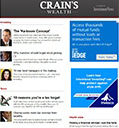
Over the past decade, adoption of automatic 401(k) plan features has boosted enrollment of new participants, increased savings rates and improved investment options through target-date funds and managed accounts. But a big challenge remains: how to plug the leakage in plan assets when workers switch jobs.
It is at these critical job-changing moments that the defined contribution system fails to meet two important tests: Safeguarding participants from cashing out their account balances and providing an efficient means to manage retirement savings.
The consequences of these failures are huge. Given that the average American worker changes jobs more than seven times over a 40-year career, the Employee Benefit Research Institute (EBRI) estimates that over a 10-year period, 401(k) cash outs will remove $1.3 trillion from the system's collective future retirement income streams.
Advertisement
Upon leaving a job, an employee can cash out and take a lump sum distribution or preserve the balance by either leaving it in the old plan (if the employer permits), rolling over the balance into an individual retirement account (IRA) or transferring it to the new employer's plan (if the new 401(k) accepts rollovers).
Plan sponsors can close accounts with less than $5,000, but they must deposit distributions between $1,000 and $5,000 in an IRA or another employer plan — unless the participant elects otherwise. Distributions from 401(k) plans are subject to income taxes plus a 10% tax penalty if the worker is younger than 55 years old at the time of separation.
HIGH CASH-OUT RATE
A staggering 45% of DC participants cash out their plan balances despite having to pay steep penalties and taxes, according to a recent report from the Boston Research Group. For job changers with balances of less than $5,000, the cash-out percentage soars to 55%.
Such cash outs reduce aggregate 401(k)/IRA retirement wealth by about 25%, according to a new study by the Center for Retirement Research at Boston College. “Leakages from 401(k)s/Individual RAs are a serious concern given that these assets are the only significant retirement savings outside of Social Security for most workers,” the report noted.
Workers who keep their savings in their old 401(k) plan or who roll over their balance to a new IRA have brighter retirement prospects than their drop-out counterparts. Still, they may confront unnecessary costs and complexity.
“Over 10 years, job changers will pay almost $44 billion to support the DC accounts that they have stranded along the way,” the BRG report said. Those costs were calculated by applying the average recordkeeping , custody and administration fee of $92 per year to the estimated 38 million “stranded” accounts in the DC system.
Now that 401(k) plans are undisputedly the primary source of retirement savings for most Americans, the system needs to evolve to reduce costly leakage and improve retirement outcomes.
“What we are promoting first and foremost is consolidation,” said Neal Ringquist, executive vice president of the Retirement Clearinghouse, a firm that helps plan sponsors improve account portability for their participants. “It is easier to manage and draw down assets when they are all together.”
Serving as a case study for the recent BRG report, the Retirement Clearinghouse applied its best practices of automatic roll-ins for new employees and rollover services for departing employees to a large health care provider client with more than 190,000 employees and a traditionally high turnover rate.
All new employees were offered the opportunity to roll in their IRA and previous DC balances into the new employer plan, enabling low-balance job changers to automatically consolidate their retirement savings. About one-third of eligible participants took advantage of the roll-in services, compared with typical plan roll-in rates of 10% or less.
“This innovation, if adopted by enough plan sponsors and record keepers, could revolutionize the DC system for frequent job changes,” the BRG report concluded.
As part of the case study, all departing employees with 401(k) balances of less than $5,000 were subject to an automatic rollover to a low-cost IRA. The key was the human touch at this critical juncture, which resulted in cutting the pre-study cash-out rate in half.
“If no assistance is offered to complete the process successfully, then participants are highly likely to opt out of the automatic rollover process and simply cash out,” the report noted.
Separated employees with balances of more than $5,000 were contacted by mail and phone to inform them of their options and to assist them in the process of creating a new IRA, consolidating balances into an existing IRA, rolling over their account balances to a new employer plan or leaving it in the old plan. Licensed counselors offered account consolidation services without the potential competing objective of asset gathering.
The BRG report pointed to these proven solutions to the 401(k) leakage problem and suggested the case study could serve as framework for future innovations. “The industry's challenge is one of agreement, adaptation, adoption and scale,” the report concluded.
The bottom line: By creating an industry-wide framework that plugs 401(k) leakage and keeps trillions of dollars in the retirement system, all parties from plan sponsors and record keepers to advisers and participants will benefit from increased balances and improved retirement outcomes.
(Questions about Social Security? Find the answers in my ebook.)










